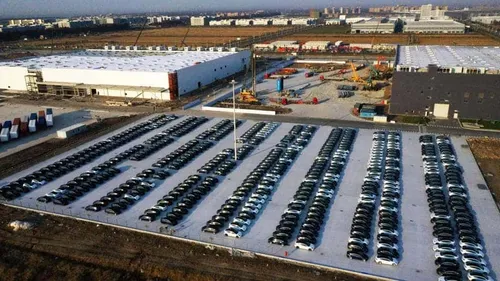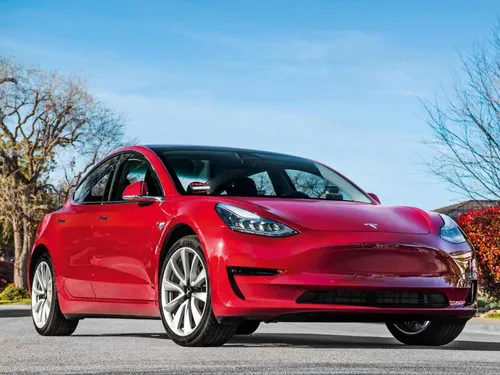Tesla Hits 5 Million Cars Produced: A Milestone in Electric Vehicle History
TechSunday, 17 September 2023 at 14:49

Tesla officially announced that it has produced a total of 5 million cars as of this week. This is about six months before the 4 millionth car rolls off the assembly line. This means that it was able to produce about a million cars in just six months which is remarkable. This is a major milestone for the company in its journey as an automaker. This article will explore the details of this achievement, including the timeline of Tesla's production growth, the significance of this milestone, and the future of Tesla's production goals.

Tesla's Production Growth
Tesla's production growth has been impressive, with the company achieving a production increase of 1 million units in just 6 months. This is a testament to the company's commitment to innovation and efficiency, as well as its ability to scale production quickly. Tesla's production growth can be seen in the following timeline:
- 2008: Tesla produced its first car, the Roadster.
- 2012: Tesla begins production of the Model S.
- 2015: Tesla begins production of the Model X.
- 2017: Tesla begins production of the Model 3.
- 2020: Tesla produces its 1 millionth car.
- 2023: Tesla produces its 5 millionth car.
- 2012: Tesla begins production of the Model S.
- 2015: Tesla begins production of the Model X.
- 2017: Tesla begins production of the Model 3.
- 2020: Tesla produces its 1 millionth car.
- 2023: Tesla produces its 5 millionth car.
This timeline shows that Tesla has achieved huge growth in a relatively short amount of time. The company has gone from producing a single-car model to producing multiple models at a rate of millions of cars per year.
The Significance of Tesla's 5 Millionth Car
The production of Tesla's 5 millionth car is a significant milestone for the company. It shows the company's ability to scale production quickly and efficiently. It also shows that there is a strong demand for electric cars. This milestone is also significant because it comes at a time when the world is facing a climate crisis. At the moment, there is a growing need for sustainable transportation options.
Tesla's 5 millionth car is also significant because it represents a historic moment in the company's journey. The car, which has not been revealed yet, is expected to be a special edition vehicle that commemorates this milestone. This vehicle will likely be highly sought after by Tesla enthusiasts and collectors.

Tesla Production Plants
Tesla currently produces cars at four factories. Two of these plants are in the United States, in Fremont, California, and Austin, Texas. In addition, Tesla also has two super factories in Shanghai, China and Berlin, Germany.
It is worth noting that the 2 millionth China-made Tesla vehicle just rolled off the assembly line at the Shanghai Gigafactory on September 6. The company said that it took less than 40 seconds for a complete vehicle to roll off the production line at it's Shanghai Gigafactory. The vehicle drove off the production line and whistled twice, indicating that the assembly was completed.
The company also said that 99.9% of the Shanghai Gigafactory are Chinese staff. Furthermore, the company states that the local rate of the parts that it uses in the factory is higher than 95%. It adopts a vertical procurement model to avoid "middlemen making the difference". The company is able to achieve this feat in China because it has all the parts and even options in the Asian country.
However, Tesla plans to build new factories outside the United States in the next few years to continue to expand its production scope. The automaker announced plans to build a new factory in Nuevo Leon, Mexico at the beginning of the year. There is also news that Tesla is considering building a factory in India. At the moment, the company is still in talks with the government to get a favorable working business environment.
The Future of Tesla's Production Goals
Tesla's production growth is expected to continue in the coming years. The company has set ambitious production goals, with the aim of producing 20 million cars per year by 2030. This goal is part of Tesla's broader mission to accelerate the world's transition to clean energy.
To achieve this goal, Tesla will need to continue to innovate and improve its production processes. The company has already made huge strides in this area, with the development of its Gigafactories and other production facilities. These facilities are designed to be highly efficient and sustainable, with a focus on reducing waste and emissions.
In addition to its production facilities, Tesla is also investing in new techs that will help to improve its production processes. For example, the company is developing new battery techs that will allow it to produce more efficient and longer-lasting batteries. This will help to reduce the cost of electric cars and make them more accessible to a wider range of users.

Conclusion
Tesla's production of its 5 millionth car is a significant milestone for the company. It demonstrates the company's ability to scale production quickly and efficiently, and it shows that there is a strong demand for electric vehicles. This milestone is also significant because it comes at a time when the world is facing a climate crisis, and there is a growing need for sustainable transportation options.
Looking ahead, Tesla's production growth is expected to continue, with the company setting ambitious goals for the future. To achieve these goals, Tesla will need to continue to innovate and improve its production processes, while also investing in new technologies that will help to reduce the cost of electric vehicles and make them more accessible to a wider range of consumers.
At the moment, the company is looking to open more factories in the U.S. and India to further expand its production line. This is a good thing because the world is now advocating for the use of sustainable energy.
Loading






